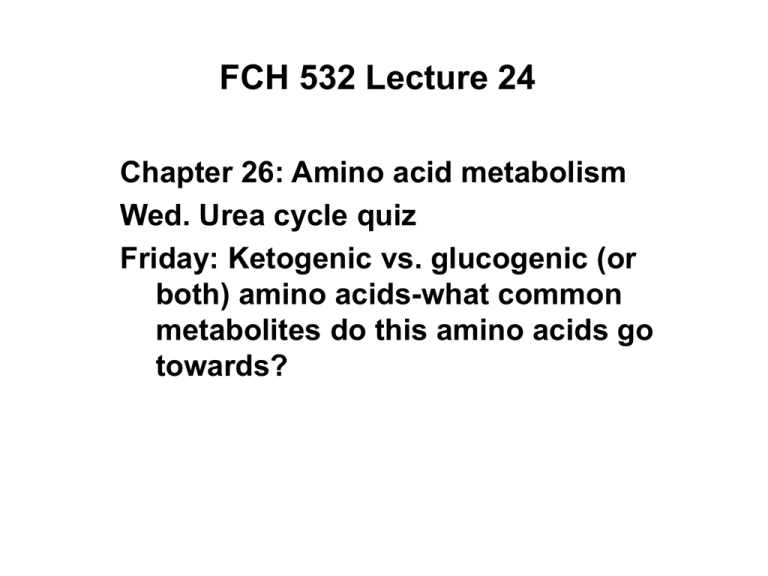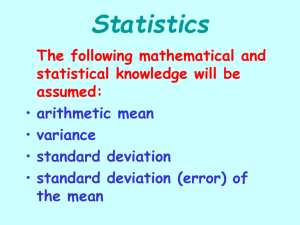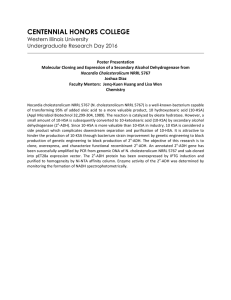FCH 532 Lecture 24
advertisement

FCH 532 Lecture 24 Chapter 26: Amino acid metabolism Wed. Urea cycle quiz Friday: Ketogenic vs. glucogenic (or both) amino acids-what common metabolites do this amino acids go towards? Page 995 Figure 26-11 Degradation of amino acids to one of seven common metabolic intermediates. Met degradation • • • • • • • Met reacts with ATP to form S-adenosylmethionine (SAM). SAM’s sulfonium ion is a highly reactive methyl group so this compound is involved in methylation reactions. Methylation reactions catalyzed by SAM yield S-adenosylhomocysteine and a methylated acceptor molecule. S-adenosylhomocysteine is hydrolyzed to homocysteine. Homocysteine may be methylated to regenerate Met, in a B12 requiring reaction with N5-methyl-THF as the methyl donor. Homocysteine can also combine with Ser to form cystathionine in a PLP catalyzed reaction and -ketobutyrate. -ketobutyrate is oxidized and CO2 is released to yield propionyl-CoA. Propionyl-CoA proceeds thorugh to succinyl-CoA. 1. Methionine adenosyltransferase 2. Methyltransferase 3. Adenosylhomocysteinase 4. Methionine synthase (B12) 5. Cystathionine -synthase (PLP) 6. Cystathionine -synthase (PLP) 7. -ketoacid dehydrogenase NADH, H+ Propionyl-CoA carboxylase (biotin) 9. Methylmalonyl-CoA racemase 10. Methylmalonyl-CoA mutase 11. Glycine cleavage system or serine hydroxymethyltransferase 12. N5,N10-methylene-tetrahydrofolate reductase (coenzyme B12 and FAD) Page 1002 8. • 1. 2. 3. Branched chain amino acid degradation Degradation of Ile, Leu, and Val use common enzymes for the first three steps Transamination to the corresponding -keto acid Oxidative decarboxylation to the corresponding acyl-CoA Dehydrogenation by FAD to form a double bond. First three enzymes 1. Branched-chain amino acid aminotransferase 2. Branched-chain keto acid dehydrogenase (BCKDH) 3. Acyl-CoA dehydrogeanse Page 1004 Figure 26-21 The degradation of the branched-chain amino acids (A) isoleucine, (B) valine, and (C) leucine. Page 1004 After the three steps, for Ile, the pathway continues similar to fatty acid oxidation (propionyl-CoA carboxylase, methylmalonyl-CoA racemase, methylmalonyl-CoA mutase). 4. Page 1004 5. 6. Enoyl-CoA hydratase - double bond hydration -hydroxyacyl-CoA dehydrogenasedehydrognation by NAD+ Acetyl-CoA acetyltransferase thiolytic cleavage For Valine: Enoyl-CoA hydratase - double bond hydration 8. -hydroxy-isobutyryl-CoA hydrolase -hydrolysis of CoA 9. hydroxyisobutyrate dehydrogenase - second dehydration 10. Methylmalonate semialdehyde dehydrogenase - oxidative carboxylation Page 1004 7. Last 3 steps similar to fatty acid oxidation For Leucine: 11. -methylcronyl-CoA carboxylasecarboxylation reaction (biotin) 12. -methylglutaconyl-CoA hydratase-hydration reaction 13. HMG-CoA lyase Page 1004 Acetoacetate can be converted to 2 acetyl-CoA Leucine is a ketogenic amino acid! Leu and Lys are ketogenic • • • • • • • Leu proceeds through a typical branched amino acid breakdown but the final products are acetyl-CoA and acetoacetate. Most common Lys degradative pathway in liver goes through the formation of the -ketoglutarate-lysine adduct saccharopine. 7 of 11 reactions are found in other pathways. Reaction 4: PLP-dependent transamination Reaction 5: oxidative decarboxylation of an a-keto acid by a multienzyme complex similar to pyruvate dehydragense and a-ketoglutarate dehydrogenase. Reactions 6,8,9: fatty acyl-CoA oxidation. Reactions 10 and 11 are standard ketone body formation reactions. Figure 26-23 The pathway of lysine degradation in mammalian liver. Saccharopine dehydrogenase (NADP+, Lys forming) 2. Saccharopine dehydrogenase (NAD+, Glu forming) 3. Aminoadipate semialdehyde dehydrogenase 4. Aminoadipate aminotransferase (PLP) 5. -keto acid dehydrogenase 6. Glutaryl-CoA dehydrogenase Page 1006 1. 7. Decarboxylase 8. Enoyl-CoA hydratase 9. -hydroxyacyl-CoA dehydrogenase 10. HMG-CoA synthase 11. HMG-CoA lyase Trp is both glucogenic and ketogenic • • • • Trp is broken down into Ala (pyruvate) and acetoacetate. First 4 reactions lead to Ala and 3hydroxyanthranilate. Reactions 5-9 convert 3-hydroxyanthranilate to aketoadipate. Reactions 10-16 are catalyzed by enzymes of reactions 5 - 11 in Lys degradation to yield acetoacetate. Page 1007 Page 1007 1. Tryptophan-2,3-dioxygenase, 2. Formamidase, 3. Kynurenine-3-monooxygense, 4. kynureninase (PLP dependent) • • • • Kynureinase, another PLP mechanism Reaction 4: cleavage of 3-hydroxykynurenine to alanine and 3-hydroxyanthranilate is catalyzed by the PLP dependent enzyme kynureinase. This facilitates a C-C bond cleavage. (previous reactions catalyzed the C-H and C-C bond cleavage) Follows the same steps as transamination but does not hydrolyze the tautomerized Schiff base. Enzyme amino acid acts as a nucleophile tto attack the carbonyl carbon (Cof the tautomerized 3hydroxykynurenine-PLP Schiff base. Page 1008 Page 1007 6. Amino carboxymuiconate semialdehyde decarboxylase 7. Aminomuconate semialdehyde dehydrogenase 8. Hydratase, 9. Dehydrogense 10-16. Reactions 5-11 in lysine degradation. -keto acid dehydrogenase • Glutaryl-CoA dehydrogenase • Decarboxylase • Enoyl-CoA hydratase • -hydroxyacyl-CoA dehydrogenase • HMG-CoA synthase • Page 1006 • HMG-CoA lyase Phe and Tyr are degraded to fumarate and acetoacetate • • The first step in Phe degradation is conversion to Tyr so both amino acids are degraded by the same pathway. 6 reactions 1. 2. 3. Page 1009 4. 5. 6. Phenylanalnine hydroxylase Aminotransferase p-hydroxyphenylpyruvate dioxygenase Homogentisate dioxygenase Maleylacetoacetate isomerase Fumarylacetoacetase Phenylalanine hydroxylase has biopterin cofactor • • • • 1st reaction is a hydroxylation reaction by phenylalanine hydroxylase (PAH), a non-heme-iron containing homotetrameric enzyme. Requires O2, FeII, and biopterin a pterin derivative. Pterins have a pteridine ring (similar to flavins) Folate derivatives (THF) also contain pterin rings. Page 1009 Figure 26-27 The pteridine ring, the nucleus of biopterin and folate. Active BH4 must be regenerated • • • • • Active form in PAH is 5,6,7,8-tetrahydrobiopterin (BH4) Produced from 7,8-dihydrobiopterin via dihydrofolate reductase (NADPH dependent). 5,6,7,8-tetrahydrobiopterin is hydroxylated to pterin-4acabinolamine by phenylalanine hydroxylase. pterin-4a-cabinolamine is converted to 7,8dihydrobiopterin (quinoid form) by pterin-4a-carbinoline dehydratase 7,8-dihydrobiopterin (quinoid form) is reduced by dihydropteridine reductase to regenerate the active cofactor. Page 1010 NIH shift • • • A 3H that starts on C4 of Phe’s ring ends up on C3 of Tyr’s ring rather than being lost to solvent. Mechanism is called the NIH shift 1st characterized by scientists at NIH 1 and 2: activation of the enzyme’s BH4 and Fe(II) cofactors to yield pterin-4acarbinolamine and a reactive oxyferryl [Fe(IV)=O2-] 3: Fe(IV)=O2- reacts with Phe to form an epoxide across the 3,4 bond. 4: epoxide opening to form carbocation at C3 5: migration of hydride from C4 to C3 to form more stable carbocation. 6: ring aromatization to form Tyr Phe and Tyr are degraded to fumarate and acetoacetate • • • • The first step in Phe degradation is conversion to Tyr so both amino acids are degraded by the same pathway. 6 reactions Reaction 1 = 1st NIH shift Reaction 3 is also an example of NIH shift (26-31) 1. 2. 3. Page 1009 4. 5. 6. Phenylanalnine hydroxylase Aminotransferase p-hydroxyphenylpyruvate dioxygenase Homogentisate dioxygenase Maleylacetoacetate isomerase Fumarylacetoacetase Amino acids as precursors • • • • • • • Amino acids are essential precursors to biomolecules: Nucleotides Nucleotide coenzymes Heme Hormones Neurotransmitters Glutathione




